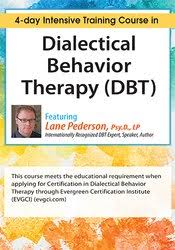Available for Pre-Order. This product will be available within a few days.
Lane Pederson – Dialectical Behavior Therapy (DBT), Intensive Certificate Course
Dialectical Behavior Therapy (DBT) has evolved from the go-to treatment for borderline personality disorder to one of the most recognized and sought after therapies for a variety of difficult to treat client problems. The increasing pressure to adopt treatments that work makes DBT skills and strategies a must-have for all types of therapists.
For those who feel that pressure but fear becoming a “manual manic”, relax. Dr. Lane Pederson teaches how to follow the manual yet make thoughtful customizations consistent with evidence-based practices and always grounded in the therapeutic alliance. Covering DBT from theory to clinical application, including the use of diary cards, behavioral analysis, contingency management, and multi-layered validation, this certificate course welcomes those implementing DBT in standard and adapted ways as well as those wishing to simply add DBT skills and techniques to their eclectic or integrative style.
If you have felt limited or stuck with your therapy skills or ready to give up on certain clients, this certificate course will breathe new life into your work. You will leave ready to use the essentials of DBT listed above as well as skills from the Mindfulness, Distress Tolerance, Emotion Regulation, and Interpersonal Effectiveness Modules with your clients, enjoying new confidence in and effectiveness with your clinical skill set.
Lane Pederson Psy.D, LP, is not affiliated or associated with Marsha M. Linehan, PhD, ABPP, or her organizations.
Discriminate DBT from the contextual model of therapy.
Evaluate DBT research in light of the contextual model and the Evidence-Based Practice of Psychology (EBPP).
Correlate DBT philosophies and interventions to the therapeutic factors that most improve outcomes.
Explore dialectic philosophies and their application in therapy.
Determine how the core assumptions of DBT are put into action in therapy.
Assess how DBT theory drives therapeutic interventions.
Communicate how to balance validation and change strategies in clinical situations.
Integrate mindfulness techniques into therapy
Implement an effective therapy structure that includes identifying clear treatment goals.
Practice how to effectively teach the four standard DBT skills modules – mindfulness, emotion regulation, distres tolerance and interpersonal effectiveness.
Design teaching strategies for skills training sessions.
Plan and teach supplemental DBT skills and modules.
Practice DBT skills training techniques in small groups.
Recommend how to seamlessly integrate DBT skills into individual therapy.
Discriminate the DBT model from cognitive-behavioral, client-centered, and other treatment modalities.
Practice a multi-layered approach to validation of clients’ thoughts and feelings.
Establish balance validation with the most effective (and practical) methods of behavior change.
Practice reciprocal and irreverent communication styles, to be utilized within the therapy session.
Comment on the key differences between traditional cognitive interventions and DBT-style cognitive interventions.
Practice therapy techniques with effective pacing, balance, and flow.
Articulate when to use (and not to use) exposure techniques.
Employ DBT diary cards and chain (change) analysis.
Propose how to operate with consultative groups and treatment teams.
Assess and manage self-injurious and suicidal behaviors with clear protocols and safety plans.
Establish clear plans for crisis management, including psychiatric hospitalizations.
Would you like to receive Lane Pederson – Dialectical Behavior Therapy (DBT), Intensive Certificate Course ?
Foundations of DBT
The Story of DBT
Explicit focus on validation
Cognitive-behavioral change strategies
Skills training
Consultative approach
Mindfulness
Dialectical balance
Five functions of DBT
Is it DBT?: What’s needed in a DBT clinical process
Dialectical Philosophy. What IS it, and HOW is it Used?
Dialectics explained
Dialectical assumptions
Dialectics in action
Dialectical Abstinence. When NOT to be dialectical
Core Assumptions of DBT: Shaping the Therapy
Acceptance and nonjudgmental stance
View of clients, therapist and therapy
DBT Models: Standard and Beyond
DBT Modes and Formats
DBT Research: Understanding and Context
Evidence-Based Practice versus
Evidence-Based Treatments
Understanding how therapy works
Six decades of empirical research
Maximizing therapeutic factors, DBT-style
Biosocial Theory: Guiding the Therapy
Biosocial theory of difficulties
How theory drives therapy
Update to Theory: RO DBT
Getting Started: Therapy Structure
Structure as a therapeutic factor
Structuring the environment
DBT Stages
Identifying treatment targets: suicidality, self-injurious behavior (SIB), therapy-interfering behavior (TIB), and other targets
Special Populations and Settings
Children and Adolescents
Substance Use Disorders
Levels of Care
Mindfulness and DBT
Mindfulness explained
Mindfulness of the approach
Mindfulness as a therapy technique
Mindfulness in life
DBT Skills Training
Integrating skills into therapy
Using skills to develop new behaviors
Methods for skills training
Mindfulness: The Path to Wise Mind
What skills: observe describe, participate
How skills: nonjudgmental, one-mindful, effectively
Mindfulness practice and application
Teaching Dialectics
Identify dialectical dilemmas
Activate Wise Mind action
For adolescents and parents: Middle path
For substance use disorders: dialectical abstinence
Distress Tolerance
Wise mind ACCEPTS
IMPROVE the moment
Pros and cons
Radical acceptance/turning the mind
Emotion Regulation
Model of emotions
PLEASED
Build positive experiences
Opposite action
Interpersonal Effectiveness
FAST skills
GIVE skills
DEAR MAN skills
Supplemental and Updated Skills and Modules
Urge surfing
Bridge burning
TIP
DBT Clinical Process
Diary Cards
Standard
Adapted for special populations
Behavioral Analysis (Chain Analysis)
Getting the client on board
Build awareness and options
Bridging into solution analysis
Starting Out: Commitment Strategies Validation
A multi-layered approach
As an exposure technique
Used dialectically with change
Difference from normalization
Change Interventions
Behavioral principals
Contingency procedures
Best behavior change methods
DBT-style cognitive interventions
Exposure Techniques
When to use (and not to use)
Exposure protocols
Alternatives to exposure
Communication Styles
Reciprocal
Irreverent
Consultative Group and Treatment Teams
Increase your motivation
Develop effective responses
Qualities of effective treatment teams
Assess and Manage Self-Injurious Behavior (SIB)
When is SIB life-threatening?
Creating alternatives
Assess and Manage Suicidal Ideation (SI)
Suicide assessment techniques
Establishing safety protocols
Safety plans and safety commitments
Hospitalization Issues
Effective use of the hospital
Transitions in and out
Next Steps
What you learned and what you need
Developing your plan
Taking action
Please Note: Lane Pederson, PsyD, LP is not affiliated or associated with Marsha M. Linehan, PhD, ABPP, or her organizations.








